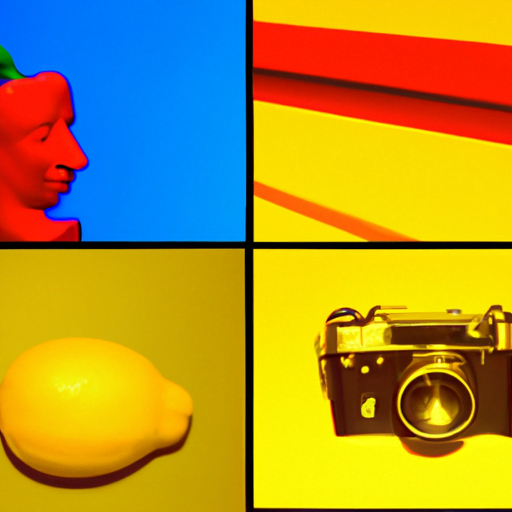Table of Contents
- The Art of Visual Juxtaposition: Creating Unexpected Combinations
- Understanding Visual Juxtaposition
- The Importance of Visual Juxtaposition
- Examples of Visual Juxtaposition
- Photography:
- Graphic Design:
- Painting:
- Case Studies: Successful Use of Visual Juxtaposition
- Apple’s “Think Different” Campaign:
- Benetton’s “United Colors of Benetton” Campaign:
- Tips for Effective Visual Juxtaposition
- Summary
The Art of Visual Juxtaposition: Creating Unexpected Combinations

Visual juxtaposition is a powerful technique used in various art forms, including photography, graphic design, and advertising. It involves combining contrasting elements to create a visually striking and thought-provoking composition. By bringing together unexpected combinations, artists can evoke emotions, challenge perceptions, and create memorable experiences for their audience. In this article, we will explore the art of visual juxtaposition, its importance, and how it can be effectively used in different contexts.
Understanding Visual Juxtaposition
Visual juxtaposition is the deliberate placement of contrasting elements within a composition to create a sense of tension, surprise, or irony. It involves combining elements that are visually dissimilar, such as colors, shapes, textures, or subjects, to create a dynamic and engaging visual experience. The contrast between these elements can create a sense of harmony, balance, or discord, depending on the artist’s intention.
One of the key aspects of visual juxtaposition is the element of surprise. When viewers encounter unexpected combinations, it grabs their attention and forces them to pause and reflect. This technique can be used to challenge conventional thinking, break stereotypes, or convey complex ideas in a visually compelling way.
The Importance of Visual Juxtaposition
Visual juxtaposition plays a crucial role in various art forms and creative disciplines. Here are some reasons why it is important:
- Creating Contrast: Juxtaposing contrasting elements helps create visual interest and impact. It allows artists to highlight specific aspects of their composition and draw attention to certain details.
- Eliciting Emotions: By combining unexpected elements, artists can evoke a wide range of emotions in their audience. Whether it’s surprise, curiosity, or even discomfort, visual juxtaposition can elicit strong emotional responses.
- Communicating Ideas: Visual juxtaposition can be a powerful tool for conveying complex ideas or messages. By combining seemingly unrelated elements, artists can create visual metaphors or analogies that communicate their intended meaning effectively.
- Breaking Patterns: Juxtaposition challenges the viewer’s expectations and breaks established patterns. This disruption can lead to new perspectives, fresh insights, and a deeper understanding of the subject matter.
Examples of Visual Juxtaposition
Visual juxtaposition can be seen in various art forms and creative works. Here are some examples:
Photography:
In photography, visual juxtaposition can be used to create compelling and memorable images. For instance, a photograph that combines a serene natural landscape with a man-made structure, such as a skyscraper, creates a striking contrast between the organic and the artificial. This contrast can evoke feelings of awe, wonder, or even concern about the impact of human development on the environment.
Graphic Design:
In graphic design, visual juxtaposition is often used to create eye-catching advertisements or posters. For example, a poster for a fitness brand that juxtaposes an image of a sedentary lifestyle with a vibrant, energetic image of a person engaged in physical activity can effectively convey the message of transformation and the benefits of an active lifestyle.
Painting:
Visual juxtaposition has been used by painters throughout history to create powerful and thought-provoking compositions. One famous example is Salvador Dali’s painting “The Persistence of Memory,” which juxtaposes melting clocks with a barren landscape. This combination of surreal elements challenges our perception of time and reality, creating a sense of unease and intrigue.
Case Studies: Successful Use of Visual Juxtaposition
Several brands and artists have successfully used visual juxtaposition to create impactful and memorable campaigns. Let’s explore a few case studies:
Apple’s “Think Different” Campaign:
In the late 1990s, Apple launched its iconic “Think Different” campaign, which featured black-and-white portraits of influential figures from various fields, such as Albert Einstein, Mahatma Gandhi, and Martin Luther King Jr. The campaign juxtaposed these historical figures with the Apple logo and the tagline “Think Different.” By associating their brand with these visionary individuals, Apple aimed to position itself as a company that challenges the status quo and encourages creativity and innovation.
Benetton’s “United Colors of Benetton” Campaign:
Benetton, a clothing brand known for its provocative advertising, has used visual juxtaposition to address social and political issues. In their “United Colors of Benetton” campaign, they combined images of people from different ethnicities, cultures, and backgrounds, wearing their colorful clothing. This juxtaposition aimed to promote diversity, inclusivity, and unity, challenging stereotypes and celebrating the beauty of differences.
Tips for Effective Visual Juxtaposition
When using visual juxtaposition in your own creative work, consider the following tips:
- Plan and Experiment: Take the time to plan your composition and experiment with different combinations of elements. Consider how each element contributes to the overall message or emotion you want to convey.
- Balance and Harmony: While contrast is essential, strive for a balance and harmony within your composition. Ensure that the contrasting elements work together to create a cohesive and visually pleasing result.
- Context and Audience: Consider the context in which your work will be viewed and the audience you are targeting. Juxtaposition can be subjective, and what may be effective in one context may not resonate with another audience.
- Experiment with Scale and Proportion: Juxtaposition can also be achieved through variations in scale and proportion. Play with different sizes and arrangements of elements to create visual interest and impact.
Summary
Visual juxtaposition is a powerful technique that can elevate creative works and captivate audiences. By combining contrasting elements, artists can create visually striking compositions that evoke emotions, challenge perceptions, and communicate complex ideas. Whether it’s in photography, graphic design, or painting, visual juxtaposition plays a crucial role in creating memorable and thought-provoking experiences. By understanding the principles and experimenting with different combinations, artists can harness the power of visual juxtaposition to create impactful and engaging works of art.


